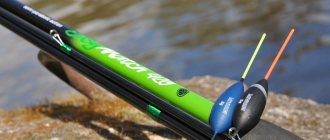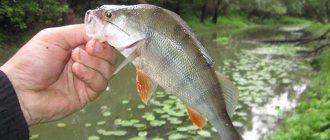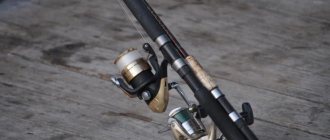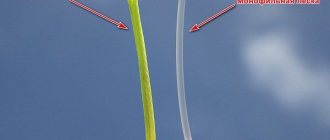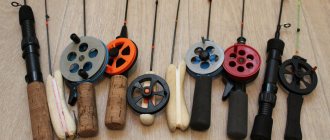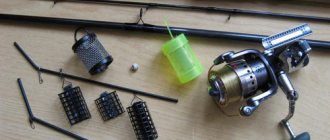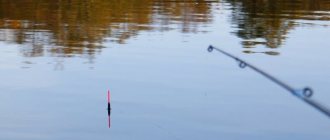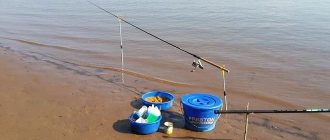What length of feeder rod to choose
The length of the feeder rod can vary from 2.7 to 4.8 meters. For the first feeder rod, it is optimal to choose a rod with a length of 3.3-3.6 m. But when choosing a feeder rod by length, you should focus on the casting distance that you will need. If you are going to fish on a small lake, pond or river, then you can safely choose a shorter rod - it will be easier for you to control and the banks abundantly overgrown with vegetation will not become a particular obstacle. If fishing will take place on a large river or reservoir with a width of more than 100-150 meters, then you will need a rod of 3.6 meters or more. Don’t forget that it’s much more pleasant to fish with a shorter and thinner rod. If you plan to catch crucian carp with a maximum weight of up to 0.5 kg, then it will be much more pleasant to fish it with more delicate tackle. In addition, when catching small fish, a rough stick absorbs much worse, which will lead to frequent fish escapes. If you plan to catch fish weighing more than 0.5 kg, and this is usually carp, silver carp and grass carp, then a rod 3.6 meters long will be most suitable. As mentioned above, a rod with a length of about 3.3-3.6 meters is the most versatile. Such a feeder will allow you to comfortably fish both in small and large bodies of water; it will cope with both large and small fish. Therefore, if you are in doubt when choosing the length of the rod, feel free to take a feeder with a length of 3.6 meters.
Feeder rod structure
According to their structure, feeder rods are divided into:
- fast;
- average;
- slow.
For a beginner, the best option would be a medium-action feeder rod, because it has average characteristics and is ideal for an inexperienced feeder. The blank of such a rod bends to the middle, which allows you to soften the jerks of large fish and, at the same time, not experience discomfort when casting.
Which feeder test to choose
The rod blank test implies the load for which it is designed, namely what weight the feeder will be used. If you use a feeder that is lighter than the test specified on the feeder form, then you will significantly lose the sensitivity of the feeder, and if the weight is higher than the upper limit of the test, then you risk breaking the rod. According to the test, feeder rods are divided into: • Ultralight (Ultralight) - up to 40 g; • Light (Light) - up to 80 g; • Average (Medium) – 80-100 g; • Heavy (Heavy) - 100-120 g; • Extra heavy (Extraheavy) - 120 g or more. The higher the rod test, the heavier the feeder can be used. Accordingly, the further you can throw the bait. Also, when choosing a fishing rod test, you should take into account the body of water, or rather the strength of the current in it. When fishing in a current, you need to choose a feeder with a weight that will not be carried away by the current, so when choosing a feeder test, focus on the speed of the current and casting distance. It is worth considering that if the bite is bad, it is better to use feeders as light as possible. Often in cold water, when the fish are very cautious, you have to fish with feeders weighing 20-30 grams. But you won’t be able to throw such a feeder with a rod with more than 60 grams of dough. Light feeders require a lighter feeder. If you haven’t fully decided which test to choose for a feeder, pay attention to the most universal option - a middle-class rod with a top test of up to 90-100 grams. This test will be optimal for a novice angler and is suitable for most fishing conditions. And then, based on your practice, you will be able to understand which test of the next feeder is best for you.
Test
The concept of a feeder test shows what load a rod can withstand using equipment. After all, the casting distance and whether the feeder can withstand such a load depends on how much the equipment weighs. One of the tasks of the feeder is to “hold” the bottom in the place where we are going to fish. These two parameters of casting and holding characterize the test. According to tests, feeder rods are divided into:
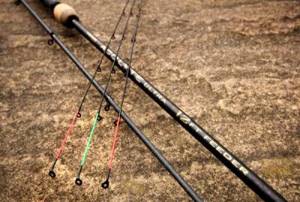
light (ultra-light) - up to 40 g (long-distance casting is not possible);- medium (average) - up to 80 degrees (casting about 40 meters);
- heavy feeder (heavy) - up to 120 gr. (the most optimal test);
- extra Heavy (super heavy) - 120 gr. and more (most popular for large fish).
Feeder material - which is better?
Their price directly depends on the material of the feeder rod. Here you must make a choice based on your financial capabilities. Let's look at each material and find out their features. 1. Graphite is the most expensive material for making a feeder. It has many advantages, the main one being its weight. The high-modulus graphite feeder is really very light and fishing with it is very comfortable. Such rods can withstand enormous loads when playing fish, but are very sensitive to mechanical damage, such as impacts on the sides of the boat, stones and other hard objects. Such rods must be handled very carefully and ensure that there is no sand or small pebbles at the junction of the knees, otherwise the rod will wear out very quickly. For beginners - not the best choice. 2. Composite. Feeder rods made of composite are much cheaper than graphite rods, but already have more weight. They no longer require such careful treatment and forgive many handling errors. So for a beginner, such a rod is quite suitable, and it will cost less. 3. Fiberglass. The cheapest feeders are made from fiberglass. This is the most durable material of all of the above. But such rods are quite heavy and rigid, which will cause some inconvenience during the fishing process. For beginners who just want to try feeder fishing, this is what you need.
The best manufacturers of feeder rods - which company to choose
For a busy amateur who has no time to delve into the details of the gear, and who plans to fish a couple of times a year, you can immediately buy a good feeder from trusted manufacturers:
- Shimano;
- Banax;
- Black Hole;
- Daiwa;
- Salmo.
But if you plan to devote more time to your hobby, then it is useful to read a comparative review of popular models of this equipment. For those who want to learn to understand all the intricacies of choosing a feeder, the material below is dedicated.
Recommendations: 14 Best Fishing Rods
14 best spinning rods for fishing
20 Best Fishing Lines
Which coil to choose for the feeder
One of the important components of a feeder rod is the reel. The best option would be a spinning reel size 4000 according to the Shimano classification (3500 according to the Daiwa classification). Choose more traction reels, that is, with a lower gear ratio, because when fishing with a feeder, rather heavy feeders are used. For this type of fishing, reels with a rear drag without a baitrunner are more convenient. The reels described above are perfect for light, medium and heavy class rods. That is, they are suitable for all classes of feeder rods, with the exception of the most extreme ones - Ultra light and Extra Heavy. But beginners, as a rule, are not interested in these classes.
Sensitivity of feeder tips and their classification
The sensitivity of the tips is a parameter that shows how much force needs to be applied to the tip of the tip so that it bends at an angle of 90 degrees. Measured in ounces, it ranges from ultra-thin tips that respond to even the slightest gust of wind, to nearly rigid 6-ounce tips.
Feeder rod tips are usually divided into three types according to the degree of rigidity (also known as sensitivity):
- Soft - for fishing in reservoirs with standing water or very weak currents.
- Medium - for fishing in medium currents or in still water in windy weather.
- Hard - for fishing in strong currents.
Choosing rod rings for a feeder rod
The core rings are very important. Their correct placement will provide the rod with the desired bend and control over the entire process.
Some types of guide rings give the feeder good controllability, while others make the rod more rigid. Here the entire dependence is determined by the size of the rings and the type of material of the fishing rod .
The ring closest to the handle is the strongest; it can withstand heavy, including accidental, load. The detail on the tip is similarly reinforced. The ring closest to the nose of the rod should be able to handle the brunt of any impacts .
The other guides that run along the base must match the strength and weight of the rod . Super-strong feeder rod guides can destroy the performance of a lightweight model, and a powerful base will not benefit from thin guides. On the contrary, she needs reliable rings to support large feeders and floats.
The number and spacing of rings also varies. A flexible rod requires more guides, up to 12 or even more. Hard fishing rods for carp, as a rule, have no more than 6 rings.
How to choose a feeder rod for beginners
Choosing a feeder due to the availability of quite a variety of products is a complex and painstaking process that is difficult for a novice feeder operator to cope with alone.
Important! The starting data for selecting gear with optimal parameters for fishing are: the structure of the reservoir and, in particular, the strength of the current, the size of the fish planned to be caught, the distance of supply of the rigs and their weight.
And these are only the most basic conditions for choosing a feeder. The intensity of fishing trips and the habits of the caught trophy, which contribute to the effective selection of a feeder rod, will not be superfluous initial information. Based on this kind of data, a fishing rod is selected according to a whole list of characteristics, among which primary attention is paid to: the length of the rod, the parameters of the removable tips of the tackle, the test, the structure and material of the feeder blank, the method of fastening and the sizes of the guide rings.
Form material
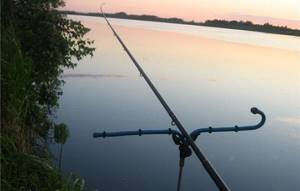
On sale you can find a feeder rod made of three types of material with similar properties, differing only in density, and therefore affecting the weight of the tackle form. Fiberglass fishing rods are the heaviest among the feeder rods. They are more rigid and less informative. Basically, a budget feeder is assembled from fiberglass, the form of which forgives many mistakes in the technique of a novice feeder operator.
The opposite of fiberglass in price terms is carbon fiber gear. These are light and sensitive fishing rods, but they are fragile and require careful handling. Such tackle is more suitable for an already experienced fisherman, because the operation of the blank will require high casting technique, as well as an initial material investment in the tackle.
The golden mean between the materials presented above is occupied by fishing rods made of composite combined materials. They are slightly inferior in weight to carbon fiber, superior to fiberglass in sensitivity, durable and not so high in price levels. It’s safe to say that the composite version is the best feeder rod for a beginner.
Optimal feeder rod length
The length of the blank affects the range of the fishing rod, and also contributes to the selection of optimal gear for fishing reservoirs with strong currents. You can choose a feeder according to the length of the form from a multiple of 30 cm. The countdown begins with fishing rods 2.7 meters long and ends with a length of 4.8 meters. For specific conditions and feeder fishing tactics, some manufacturers deviate from these rules and produce forms that differ in length from generally accepted measures.
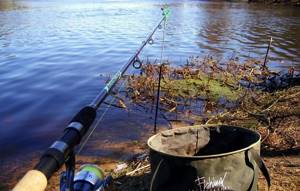
The classic length range suitable for most fishing conditions is considered to be from 3.3 to 3.9 meters. These optimal feeder lengths provide high range and sensitivity, allow you to fish with various types of rigs and confidently cope with landing large fish.
Rod test and feeder classes
The test is an important characteristic of the form, indicating the limit of the load-carrying capacity of the gear.
Important! The test parameter must be indicated by markings on feeder rods.
The weight of the thrown equipment should not exceed the recommended limits. Limits are usually divided into corresponding classes, knowing the ranges of which you can quickly select the optimal gear for fishing conditions based on this parameter.
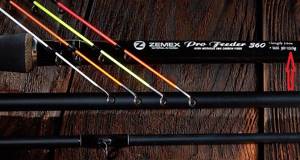
Feeders are divided into the following classes:
- Installations whose weight does not exceed 30 grams can be fed with a light feeder .
- It is optimal to throw feeders weighing up to 60 grams with a medium-light .
- medium fishing rod is designed for casting rigs from 60 to 80 grams.
- medium-heavy class means that the whip is optimal for fishing with rigs weighing from 80 to 100 grams.
- Heavy feeders provide the feeder with casting equipment from 100 to 120 grams.
- Heavy models of the extra-heavy are designed for fishing with feeder weights over 120 grams.
Exceeding the recommended numerical values is fraught with creases in the quiver tip of the fishing rod and radically affects the range of the feeder.
What should the system be like?
The structure of the tackle characterizes its sensitivity and information content, depending on the rigidity of the blank. In the fishing environment, it is customary to divide this characteristic into three main types: fast, medium and slow. In turn, each of the three main types is divided into subtypes that more accurately characterize the parameter. Fast action is the most sensitive and informative, but this kind of forms, due to their increased rigidity, do not work well when fishing for especially heavy trophies. Slow action, on the contrary, copes quite well with compensating for excess loads during fishing, but such whips do not have a long range and are poorly informative.
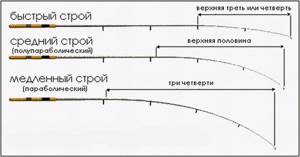
Closer to universal, a feeder fishing rod with a medium action is considered. The parameters of this type of form have balanced performance characteristics that can give you a good feel for the connection, and also not be afraid for the comfortable hauling of the trophy. It is recommended for a beginner in feeder fishing to purchase just such medium-action rods, ranging from the medium class to the heavy feeder classification.
Comfortable handle
The most common in retail chains are feeders with cork or neoprene handles. The practice of bottom fishing using the feeder method shows that neoprene handles are the most efficient in use. The weight of a neoprene handle is only slightly different from the weight of the same type of cork product, and in terms of ergonomics and tactility, the difference in materials is small, but neoprene does not absorb moisture and is an elastic material in structure that can withstand significant deformations, which become critical for cork, causing it to crumble.
By type, handles are divided into solid and spaced types. The spaced type indicates the long range of the rod and its powerful component. For example, the vast majority of models in the extra heavy feeder class have a split handle.
Guide rings on the rod
All feeder rod blanks are equipped with guide rings designed to secure the cord and evenly distribute the load that occurs during casting and retrieving the trophy. The number of rings depends on the length of the feeder rod and its power. The guide rings increase in diameter from the quiver tip to the butt of the tackle; moreover, their mounting supports or legs can be made in a reinforced version, when instead of a pair of elements, the ring is connected to the blank with three supports. The ring inserts also differ in the type of material.
Important! Ceramic liners are considered the most reliable options for the inner part of the rings.
They have zero roughness, minimizing the friction force of the cords when casting. In addition to ceramics, the liner can be made of corrosion steel or plastic. Plastic is the cheapest and most unreliable type of material for a ring insert. A blank with such rings has a low rating among feeder rods; it quickly renders the monofilament or braided rod unusable, and it is better for the fisherman to refuse to purchase such equipment, preferring to choose inserts made of metal or ceramic.
Quivertypes and their role
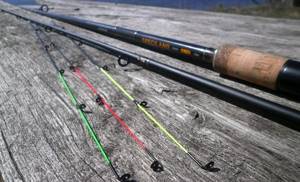
A real and high-quality feeder rod is equipped with a replaceable set of quivertips or working tips, which differ in the amount of rigidity. Depending on this parameter, the working elements are painted in different colors, most often red, yellow and green, to quickly visually determine their characteristics.
The main functions of the quiver tip are to absorb the jerks of the fish being caught, as well as to signal a bite. Soft and sensitive tips are suitable for fishing in standing and low-flowing water bodies. Tips of medium hardness are designed for fishing in windy weather and moderate currents. Tough, as feederists say, oak quivertips are used for strong traction and at great fishing depths. Sometimes, under such extreme conditions, anglers use a conventional spinning rod for feeder fishing, where the end of the tackle form reacts to a bite.
